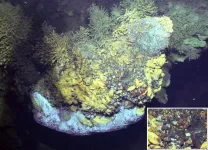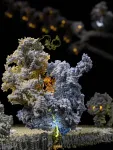HKUST decodes a deep-sea vent-endemic snail hologenome
Unveiling its living strategies in the extreme environment
2021-02-19
(Press-News.org) A research team led by Prof. QIAN Peiyuan, Head and Chair Professor from the Hong Kong University of Science and Technology (HKUST)'s Department of Ocean Science and David von Hansemann Professor of Science, has published their cutting-edge findings of symbiotic mechanisms of a deep-sea vent snail (Gigantopelta aegis) in the scientific journal Nature Communications. They discovered that Gigantopelta snail houses both sulfur-oxidizing bacteria and methane-oxidizing bacteria inside its esophageal gland cells (part of digestive system) as endosymbionts. By decoding the genomes of both snail host and two symbionts, Prof. Qian's team disclosed a novel dual symbiosis system and the molecular adaptation to the extreme environment, gaining a new understanding of the origin of life on Earth.
Deep-sea hydrothermal vent is characterized as extremely high hydrostatic pressure and darkness, and they can release fluids overheated by the Earth's crust, with concentrated toxic heavy metals and chemical substances. These characteristics make hydrothermal vent one of the most uniquely extreme environments on our planet. In addition, the deep-sea hydrothermal vent environment is very similar to the earth's early environment, when life began to form. Unlike most ecosystems relying on photosynthesis-derived nutrients, fauna living in vents depend on chemosynthetic microbes that can utilize chemical energy to synthesize organic compounds, supporting dense and unique macro-organisms living there. However, how the organisms thrive and adapt to such an extreme environment remains a complex puzzle.
In April and May 2019, Prof. Qian's team undertook a deep-sea research expedition and explored Longqi vent filed on the Southwest Indian Ridge with a remotely operated vehicle. They found a dominant species, Gigantopelta snails, at the sea floor (approximate 2800 m depth). Prof. Qian's team discovered two types of symbiotic bacteria with dramatically different morphologies that live inside the esophageal gland cells of Gigantopelta snails, which was further identified as one sulfur-oxidizing bacteria and one methane-oxidizing bacteria.
The team further decoded the genomes of Gigantopelta snail, sulfur-oxidizing bacteria and methane-oxidizing bacteria, unveiling a novel dual symbiosis system that are highly versatile in utilizing the chemical energy for nutrient synthesis. The sulfur-oxidizing bacteria can utilize the chemical energy from hydrogen, hydrogen sulfide, sulfate, sulfite and thiosulfate, while the methane-oxidizing bacteria can utilize hydrogen and methane. From the host side, there are more copies of pattern recognition receptors in Gigantopelta genome, and they specifically expressed in the symbiotic organ, which help Gigantopelta recognize and maintain a dual symbiosis system. Gigantopelta snails adopt a mutualistic metabolic relationship among multiple symbiotic partners and thus flourish in this vent ecosystem. These findings not only enable us to gain a better understanding of how animals thrive in such extreme environment, but also shed light on how such animals cope with microbes in a highly specialized way.
INFORMATION:
[Attachments] See images for this press release:

ELSE PRESS RELEASES FROM THIS DATE:
2021-02-19
A new study looking at how COVID-19 affects people with asthma provides reassurance that having the condition doesn't increase the risk of severe illness or death from the virus.
George Institute for Global Health researchers in Australia analysed data from 57 studies with an overall sample size of 587,280. Almost 350,000 people in the pool had been infected with COVID-19 from Asia, Europe, and North and South America and found they had similar proportions of asthma to the general population.
The results, published in the peer-reviewed END ...
2021-02-19
Researchers at the University of Illinois Chicago have discovered a way to convert the methane in natural gas into liquid methanol at room temperature.
This discovery, reported in the journal Proceedings of the National Academy of Sciences, could potentially provide a cleaner energy source for many of our everyday activities.
When burned, natural gas -- the fuel used to heat homes, cook food and generate electricity -- produces carbon dioxide, a powerful greenhouse gas.
According to the U.S. Energy Information Administration, the U.S. consumed approximately 31 trillion cubic feet of natural gas in 2019, contributing roughly 1.6 gigatons of carbon dioxide to the atmosphere.
A better way to use natural gas would be to convert it to methanol, a liquid fuel that burns more ...
2021-02-19
University of Queensland scientists have developed an ultraviolet 'television' display designed to help researchers better understand how animals see the world.
Until now, standard monitors on devices like televisions or computer screens have been used to display visual stimuli in animal vision studies, but none have been able to test ultraviolet vision - the ability to see wavelengths of light shorter than 400 nanometres.
Dr Samuel Powell, from the Queensland Brain Institute's Marshall lab, said this new technology will help unveil the secrets of sight in all sorts of animals, such as fish, birds and insects.
"Human TVs generally use three colours - red, green and blue - to create images, but our newly-developed ...
2021-02-19
Mitochondria are organelles that act as the powerhouses in our body. They use oxygen which we inhale and food we eat to produce energy that supports our life. This molecular activity is performed by bioenergetic nano-factories incorporated in specialized mitochondrial membranes. The nano-factories consist of proteins cooperatively transporting ions and electrons to generate chemical energy. Those have to be constantly maintained, replaced and duplicated during cell division. To address this, mitochondria have their own bioenergy protein-making machine called the mitoribosome. Given its key role, a deregulation of the mitoribosome can lead to medical disorders such as deafness and diseases including cancer development. The first fundamental understanding of how mitoribosomes ...
2021-02-19
A POSTECH-KAIST joint research team has successfully developed a technique to reach near-unity efficiency of SHEL by using an artificially-designed metasurface.
Professor Junsuk Rho of POSTECH's departments of mechanical engineering and chemical engineering, and Ph.D. candidate Minkyung Kim and Dr. Dasol Lee of Department of Mechanical Engineering in collaboration with Professor Bumki Min and Hyukjoon Cho of the Department of Mechanical Engineering at KAIST have together proposed a technique to enhance the SHEL with near 100% efficiency using an anisotropic metasurface. For this, the joint research team designed a metasurface that transmits most ...
2021-02-19
Photo and map
Robotic laboratories on the bottom of Lake Erie have revealed that the muddy sediments there release nearly as much of the nutrient phosphorus into the surrounding waters as enters the lake's central basin each year from rivers and their tributaries.
Excessive phosphorus, largely from agricultural sources, contributes to the annual summer cyanobacteria bloom that plagues Lake Erie's western basin and the central basin's annual "dead zone," an oxygen-starved region that blankets several thousand square miles of lake bottom and that reduces habitat for fish and other organisms.
The release of phosphorus from Lake Erie sediments during periods of low oxygen--a phenomenon known as self-fertilization or internal loading--has been acknowledged since the 1970s. ...
2021-02-19
We are most familiar with the four conventional phases of matter: solid, liquid, gas, and plasma. Changes between two phases, known as phase transitions, are marked by abrupt changes in material properties such as density. In recent decades a wide body of physics research has been devoted to discovering new unconventional phases of matter, which typically emerge at ultra-low temperatures or in specially-structured materials. Exotic "topological" phases exhibit properties that can only change in a quantized (step-wise) manner, making them intrinsically robust against impurities and defects.
In addition to topological ...
2021-02-19
Despite our great progress in understanding various cellular mechanisms over the last decades, many of them remain unclear. Such is the case for exosomes, small vesicles released by cells that contain genetic materials called "RNA" and various proteins. The roles of exosomes are believed to be very varied and important, both for normal bodily functions and also in the spreading of diseases like cancer. However, exosomes are so small that studying them is challenging and calls for costly and time-consuming techniques, such as electron microscopy (EM).
To tackle this issue, a team of undergraduate students from ...
2021-02-19
Scientists have achieved a breakthrough in predicting the behaviour of neurons in large networks operating at the mysterious edge of chaos.
New research from the University of Sussex and Kyoto University outlines a new method capable of analysing the masses of data generated by thousands of individual neurons.
The new framework outperforms previous models in predicting and assessing network properties by more accurately estimating a system's fluctuations with greater sensitivity to parameter changes.
As new technologies allow recording of thousands of neurons from living animals, there is a pressing demand for mathematical tools to study the non-equilibrium, complex dynamics of the high-dimensional ...
2021-02-19
Cancer researcher Rita Fior uses zebrafish to study human cancer. Though this may seem like an unlikely match, her work shows great promise with forthcoming applications in personalised medicine.
The basic principle of Fior's approach relies on transplanting human cancer cells into dozens of zebrafish larvae. The fish then serve as "living test tubes" where various treatments, such as different chemotherapy drugs, can be tested to reveal which works best. The assay is rapid, producing an answer within four short days.
Some years ago, when Fior was developing this assay, she noticed something curious. "The majority of human ...
LAST 30 PRESS RELEASES:
[Press-News.org] HKUST decodes a deep-sea vent-endemic snail hologenome
Unveiling its living strategies in the extreme environment





